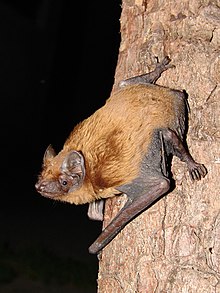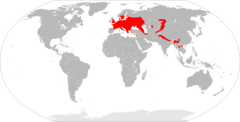
The Mexican free-tailed bat or Brazilian free-tailed bat is a medium-sized bat native to the Americas, so named because its tail can be almost half its total length and is not attached to its uropatagium. It has been claimed to have the fastest horizontal speed of any animal, reaching top ground speeds over 99 mph (160 km/h). It also flies the highest among bats, at altitudes around 3,300 m (10,800 ft).

The New Zealand lesser short-tailed bat is a small-sized omnivorous mammal endemic to the islands of New Zealand. It is one of two extant and three overall terrestrial mammal species unique to New Zealand. Its closest relative, the New Zealand greater short-tailed bat, was last seen in 1965 and is presumed extinct due to intense predation from ship rats introduced in the last few centuries. These bats are also commonly referred to as pekapeka, their Māori-language name. Lesser short-tailed bats have unique adaptations that differentiate them from bats found in other parts of the world. For example, they are fully capable of moving along the ground to search for food, and the males sing to attract partners, taking turns to do so. Lesser short-tailed bats are a vulnerable species, so extensive conservation work and research are being done to prevent extinction.

The big brown bat is a species of vesper bat distributed widely throughout North America, the Caribbean, and the northern portion of South America. It was first described as a species in 1796. Compared to other microbats, the big brown bat is relatively large, weighing 15–26 g (0.53–0.92 oz) and possessing a wingspan of 32.5–35 cm (12.8–13.8 in).

The serotine bat, also known as the common serotine bat, big brown bat, or silky bat, is a fairly large Eurasian bat with quite large ears. It has a wingspan of around 37 cm (15 in) and often hunts in woodland. It sometimes roosts in buildings, hanging upside down, in small groups or individually. The name serotine is derived from the Latin serotinus, which means 'evening', while the generic name derives from Greek ἔπιεν and οίκος, which means 'house flyer'.
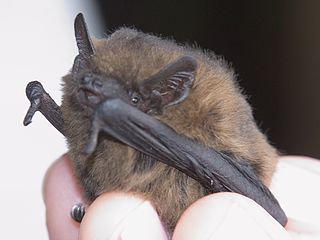
The common pipistrelle is a small pipistrelle microbat whose very large range extends across most of Europe, North Africa, South Asia, and may extend into Korea. It is one of the most common bat species in the British Isles. In Europe, the northernmost confirmed records are from southern Finland near 60°N.

The greater horseshoe bat is an insectivorous bat of the genus Rhinolophus. Its distribution covers Europe, Northern Africa, Central Asia and Eastern Asia. It is the largest of the horseshoe bats in Europe and is thus easily distinguished from other species. The species is sedentary, typically travelling up to 30 kilometres (19 mi) between the winter and summer roosts, with the longest recorded movement being 180 km (110 mi). The frequencies used by this bat species for echolocation lie between 69–83 kHz, have most energy at 81 kHz and have an average duration of 37.4 ms.

The Jamaican, common, or Mexican fruit bat is a frugivorous bat species native to the Neotropics.

The greater noctule bat is a rare carnivorous bat found in Europe, West Asia, and North Africa. It is the largest and least studied bat in Europe with a wingspan of up to 46 centimetres (18 in) and is one of the few bat species to feed on passerine birds. Greater noctule bats are the only bat species to hunt birds on the wing rather than when roosting. The greater noctule bat has wings adapted for open-air hunting and uses echolocation frequencies above the hearing range of birds.
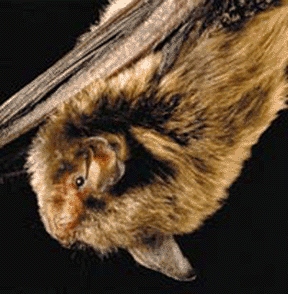
The Indiana bat is a medium-sized mouse-eared bat native to North America. It lives primarily in Southern and Midwestern U.S. states and is listed as an endangered species. The Indiana bat is grey, black, or chestnut in color and is 1.2–2.0 in long and weighs 4.5–9.5 g (0.16–0.34 oz). It is similar in appearance to the more common little brown bat, but is distinguished by its feet size, toe hair length, pink lips, and a keel on the calcar.

The pallid bat is a species of bat that ranges from western Canada to central Mexico. It is the sole species of its genus and is closely related to Van Gelder's bat, which is sometimes included in Antrozous. Although it has in the past been placed in its own subfamily (Antrozoinae) or even family (Antrozoidae), it is now considered part of the subfamily Vespertilioninae and the tribe Antrozoini.

The western barbastelle, also known as the barbastelle or barbastelle bat, is a European bat in the genus Barbastella. This species is found from Portugal to Azerbaijan and from Sweden to Canary Islands, where a sub-species was identified. It has a short nose, small eyes and wide ears. The conservation status of B. barbastellus is assessed as "near threatened", "vulnerable", "critically endangered" or "extinct" in various parts of its range.

The soprano pipistrelle is a small species of bat. It is found in Europe and often roosts on buildings.

The lesser noctule, Leisler's bat or the Irish bat, is a species of insectivorous bat belonging to the vesper bat family, Vespertilionidae. The species was named to honour the naturalist Johann Philipp Achilles Leisler.

The Azores noctule is a species of bat found in the dry forests of the Azores. It is the only species of mammal endemic to the Azores. It has been recorded on most of the islands of the Azores, and remains common on some but is rare on others. Its numbers are threatened due to habitat loss caused by humans, and the remaining populations are quite fragmented. It is known to roost in hollowed-out trees, buildings, and caves.

The Mexican long-tongued bat is a species of bat in the family Phyllostomidae. It is the only species within the genus Choeronycteris. The species is found in El Salvador, Guatemala, Honduras, Mexico, and the United States.

Sundevall's roundleaf bat, also called Sundevall's leaf-nosed bat, is a species of bat in the family Hipposideridae.
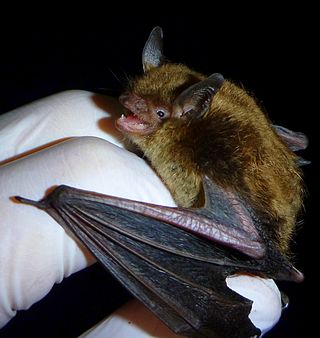
The little brown bat or little brown myotis is an endangered species of mouse-eared microbat found in North America. It has a small body size and glossy brown fur. It is similar in appearance to several other mouse-eared bats, including the Indiana bat, northern long-eared bat, and Arizona myotis, to which it is closely related. Despite its name, the little brown bat is not closely related to the big brown bat, which belongs to a different genus.

Nyctalus is a genus of vespertilionid bats commonly known as the noctule bats. They are distributed in the temperate and subtropical areas of Europe, Asia and North Africa.

Myotis septentrionalis, known as the northern long-eared bat or northern myotis, is a species of bat native to North America. There are no recognized subspecies. The northern long-eared bat is about 3–3.7 inches in length, with a wingspan of 9–10 inches. It is distinguishable by its long ears when comparing it to other bats in its genus. This species is commonly found in the northern United States and Southern Canada east of British Columbia. The geographic range includes 37 states.
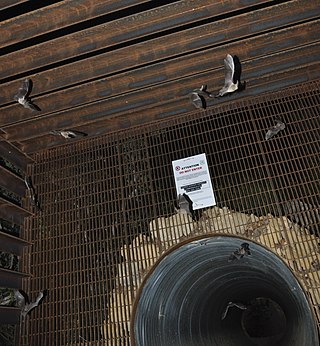
A maternity colony refers to a temporary association of reproductive female bats for giving birth to, nursing, and weaning their pups. The colonies are initiated by pregnant bats. After giving birth, the colony consists of the lactating females and their offspring. After weaning, juveniles will leave the maternity colony, and the colony itself will break apart. The size of a maternity colony is highly variable by species, with some species forming colonies consisting of ten or fewer individuals, while the largest maternity colony in the world in Bracken Cave is estimated to have over 15 million bats.
